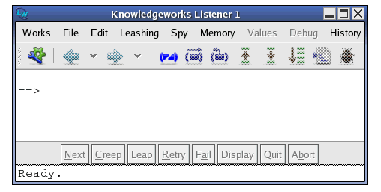






Figure 5.2 KnowledgeWorks Listener


The KnowledgeWorks Listener is obtained by choosing KnowledgeWorks > Listener . This tool is based on the LispWorks Common Prolog Logic Listener (see Common Prolog for further details). Input is taken as being a goal expression to be satisfied unless no predicate of that name and arity (number of arguments) exists in which case it is taken as a Lisp expression. That is, the input may be either
<expression>
as defined in Forward chaining, or
<lisp-expr>
with the former interpretation taking priority when ambiguous. Interaction is Prolog-style, so when the bindings which satisfy a goal are printed, pressing
Return
terminates execution, and entering
;
(semi-colon) and
Return
(or just clicking on the
Next
button at the bottom) looks for the next solution to the goal.
The File , Leashing and Spy menus behave as for the Common Prolog Logic Listener (see Common Prolog) and the Values , Debug and History menus behave as for the Lisp Listener (see the LispWorks IDE User Guide ).